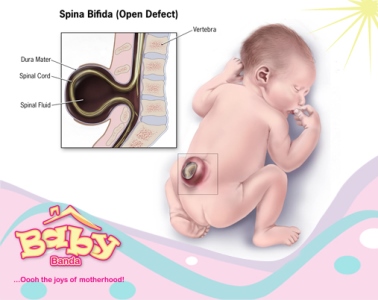This largely means “cleft spine,” and is characterized by the incomplete development of the brain, spinal cord, and/or meninges (the protective covering around the brain and spinal cord). In Spina Bifida, there is a developmental defect of the spinal column in which the arches of one or more of the spinal vertebrae fail to fuse.
Causes of Spina Bifida
1. Genetic Factors.
2. Environmental Factors e.g. taking certain medication in early pregnancy.
3. Low folic acid consumption by the mother during pregnancy.
Signs of Spina Bifida
The symptoms of spina bifida vary from one child to the other, depending on the type and level of involvement.
- Sometimes there may be no signs and it is only realized later by the use of an x-ray.
- Swelling.
- Small dimple or tuft of hair at the sight of the malformation.
- There may be a fluid-filled sac-visible on the back protruding from the spinal canal or the sac may be covered by a thin layer of skin or fully exposed.
- Muscle weakness.
- Paralysis.
- Loss of sensation.
- Respiratory difficulties.
- Fluid buildup (hydrocephalus).
- Brain damage.
- Seizures.
- Blindness.
Management of Spina Bifida
Treatment depends on the type and severity of the disorder. Generally, children with the mild form need no treatment, although some may require surgery as they grow. Other interventions include:
- Antibiotics: If the spinal cord is exposed to the environment, antibiotics may be essential in preventing infection of the central nervous system.
- Surgery: If the spinal cord is exposed to the environment or tethered, surgery is performed in order to cover the spinal cord with muscle and skin or to untether the spinal cord.
- Careful observation: The doctor may decide to monitor your baby closely, especially if there seems to be signs of hydrocephalus, paralysis, blindness and convulsions. Any changes in mental status or behaviour should be quickly brought to the attention of your doctor.
- Physical therapy: Spinal cord damage can cause muscle weakening and wasting. Physical therapy helps to strengthen the muscles.
- Assistive Devices: Use of assistive devices liked braces, crutches and wheelchairs.
Prevention of Spina Bifida
Folate intake (FOLIC ACID)
It is recommended that women of child-bearing age take 400 micrograms of folate per day and pregnant women should take 600 micrograms of folate per day. Folate can decrease the risk of Spina bifida by up to 75%. You can also get folic acid from your diet. Foods rich in folate include dark leafy greens e.g. traditional greens like managu and terere, broccoli, citrus fruits, beans, peas, avocado, nuts, beetroot, maize and lentils.













